THE
COLOBUS MONKEYS
A
road accident at Diani of the South Coast to Mombasa
It
was the low tide during the breakfast time so we decided to get after
some
other chores before the tide comes back. We would go down to the beach
to relax
in our reserved long-chairs under a parasol of palm leaves later. With
the
incoming tide we be would able to wade into the sea close our favorite
secluded
cove. It was decided that Ljiljana should go shopping to the nearby
bazaar some
300m outside of Resort’s gate. When she left the restaurant I went to
our room
to prepare everything for our usual daytime routine at the Diani beach.
It
stretches all along the Leisure Lodge Resort compound that is our
favorite
place for many years now. We were spending our winter holidays mostly
in
January like this time in 2005 too.
Some
hours passed for me waiting in the room so I got concerned about my
wife too
long absence. I went to meet my wife at the hotel lobby as she might
have been
delayed for some reason at shopping mall. The way to the lobby is not a
short
one though and it takes more time due to the increasing heat and
humidity. I
have worried about Ljiljana as she had a knee replacement surgery some
months
ago so she could not stroll in her usual vigorous way yet. At last I
met her
almost out of breath at the concierge’s desk talking on phone to
somebody. Few
moments later she told about what has happened on the main road outside
the
compound and why she looks so troubled now.
She
had to pass by wood carver’s stalls on her way back from the bazaar. As
she was
talking to few carvers she knows well for years out she heard
startlingly a thump
as if a car hit something soft. An animal whimper followed it instantly
and
when turning she saw two Colobus monkeys rushing into the nearby bush.
Behind a
smaller monkey the second larger animal limped and swayed obviously
being the
stricken one. Ljiljana run as fast she could after the car shouting
after the
driver to stop his car. At last the car stopped so she caught up with
it
exhausted and perspiring profusely. Nonetheless she was still strong
enough to
shout at the driver who got out of his car somehow amazed why a white
lady got
so excited. He was an Englishman on holiday and obviously had not
noticed or
did not care for that he run over a Colobus monkey. The Colobus monkeys
are the
endangered species in southern Kenyan coastal forest regions.
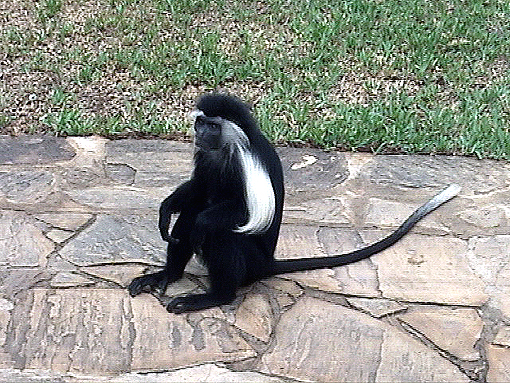
A mature Colobus monkey sits on flagstones of the hotel footpath.
After a few moments of utter confusion the tempers cooled down a little bit so Ljiljana suggested to call in the local Primate’s Conservation office for help. One of the wood-carvers joined in and offered to show the unfortunate driver to the office that was about a mile down the road only. Ljiljana picked up her shopping bags and returned to the hotel to phone the Office alerting them regarding the accident. This was the moment when I saw her talking on the phone to somebody of the Colobus Trust that is known under the name: WAKALUZU. In did not last long when one young professional came looking for her and told her that they found a Colobus female near the place it run into bush. However the infant could not be traced. The monkey was so badly bruised that by the first diagnosis there was little hope for its survival due to doubtless severe internal injuries.
The
local Primate’s Conservation is known under
the name WAKULUZU: FRIENDS OF THE COLOBUS TRUST. The WAKALUZU is a native name for the Colobus
monkeys
given by the local Digo people who leave in Diani region. For one
Colobus one
says MKULUZU whereas many of are called WAKALUZU. Nowadays one calls
the
Colobus monkey MBEGA in the local colloquial. For those
interested the address of the COLOBUS TRUST is stated at the end of
this
report.
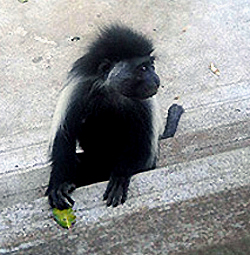
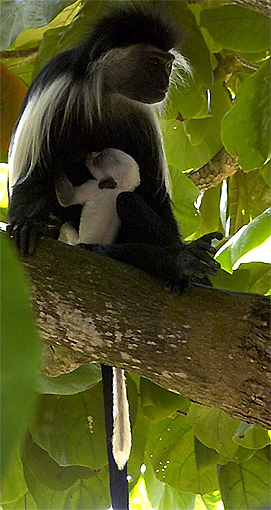
What
we should know about the
ANGOLAN BLACK AND
WHITE COLOBUS (Colobus
angolensis angolensis)
Colobine
monkeys (Family Cercopithecidae; Subfamily colobinae)
are found in
More than 400 Angolan Colobus monkeys have been
identified at the Diani region of the South Coast of Mombasa – the
highest
concentration of this species. Overall some 2000 species are estimated
in the
ICUN (World Conservation Union) red data
list so the Angolan Colobus is considered as the largely endangered in
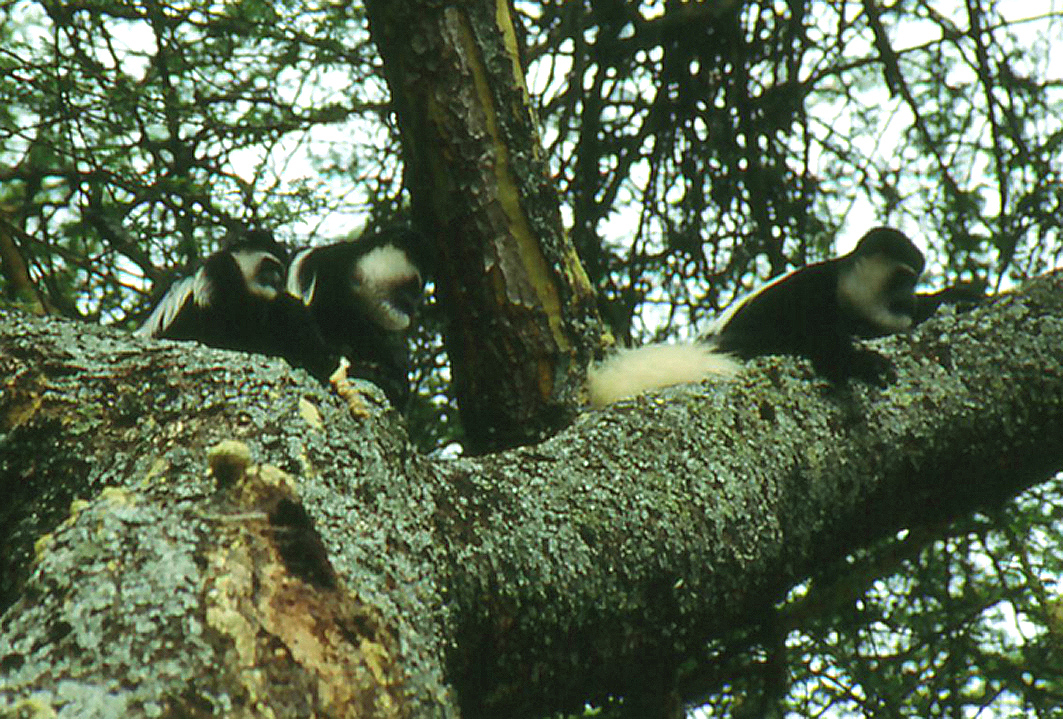
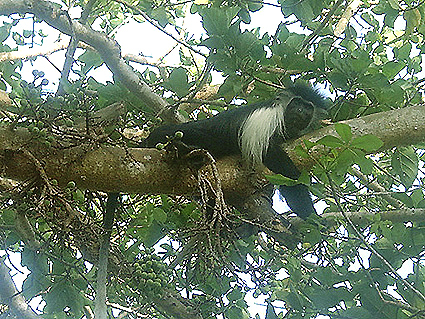
Angolan black & white Colobus monkeys photographed at Naivasha Lake (Western Kenya).
The Angolan black and white Colobus monkey has black hair with a white brow band, cheeks, and throat. Long haired white epaulettes stream from the shoulders. The lower part of the tail is white as is the band on the buttocks. The Palliatus subspecies can be found in the southern Kenyan coastal forests and the northern Tanzanian highlands only. Previously it lived along the entire coast but the deforestation in the northern parts has resulted in their restriction to isolated pockets of forests south of
The
Angolan Colobus monkeys are diurnal, have
flattened nails and pads on their
buttocks, and their hind legs are longer than their fore limbs as a
typical
characteristics of old world monkeys. However, the specific features of
“Colobines”
are due to their unique dietary adaptations. Colobus eat mostly leaves
(and
some fruits and flowers), have no cheek pouches, are arboreal and
rarely come
down to the ground. They have a light-weight bone structure and
elongated limbs
and have no thumbs though they retain an opposable big toe. The
reduction of
the thumb is an adaptation to arboreal living as the fingers have
become
aligned into a single, narrow curved arc that allows the hand to act as
a
flexible hook. In fact the Colobus acquired its name from the Greek
word "kolobos" meaning maimed or
mutilated.
The
diet of a Colobus consists of young and
mature leaves of mainly 5 available sorts. Due to the poor nutritional
quality
the monkeys have to browse in intensively for many hours per day. They
digest 2
to 3kg of leaves per day (one third of their full body weight), and
also eat
seeds, unripe fruits and flowers. In Diani region the Colobus are
rarely a pest
to the tourists since they do not eat human food and hang around in the
tree
canopy. Also the Colobus are a true "flagship" species upon which one
can determine the overall health of the forest.
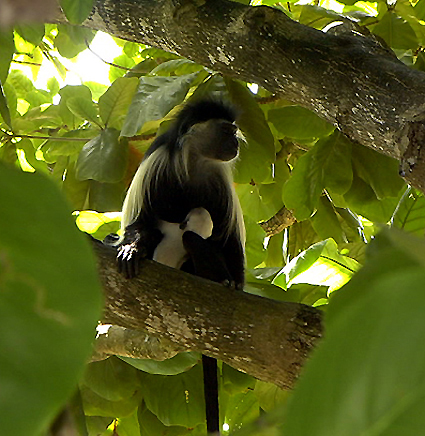
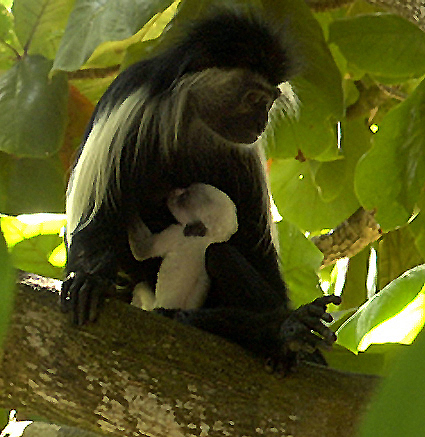
Infants are born strikingly white, and then turn gray and black. By three months of age they turn to the adult coloration of black and white. They are born throughout the year but a birth peak is seen in September and October. Colobine infants are known for their flamboyant coloration, which is remarkably different than the adult. This is considered an adaptation for encouraging the “Aunt’s behavior” where other females in the group are attracted to the newborn and spend time caring for the young. This supposedly frees up maternal time for feeding. To Colobine the nutritional value of their diet is low and the stresses of rearing offspring put enormous pressure on the female. The “Aunt’s behavior” thus counteracts the burden of nursing. Females remain in their natal troops for life. The dominant male defends the territory and troop from predators whereas the dominant female leads the troop. Young males leave their natal troop to start bachelor groups or to travel alone until they are able to take over their own troop.
THE
ENVIRONMENT OF DIANI
A
survey carried out by the Colobus Trust in 18 local
hotels and cottages in October 2002.
Despite
the hotels having erected “Do not feed the monkeys” signs, approx. one fifth of
guests were
still offering them food. The
reasons for
this vary: some tourists did
it
because they had the misconception that the monkeys were
starving while
others did it for sheer amusement. Feeding monkeys, directly or
indirectly,
makes them bold and often aggressive. Also hotels complain that the
monkeyskeys are causing losses
through destruction of
property and stealing of food.
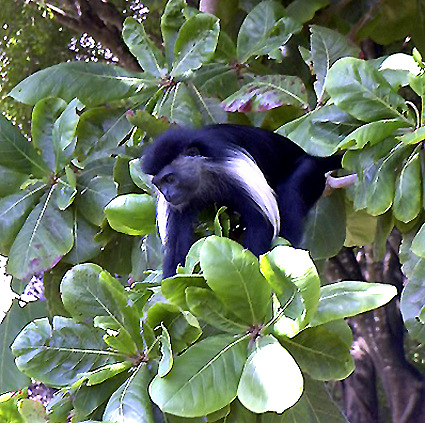
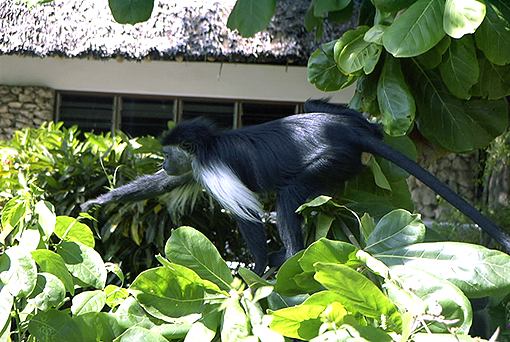
Mature Colobus monkey aka Mkaluzu (colloq. Mbega) eat fresh young leaves in hotels garden.
If
you have been to Diani, you surely would have seen “Colobridges” - the
ladders
that span the
Non-insulated power lines are numerous in Diani. As tree
branches often come into contact with the power lines, primates, and
particularly the Angolan Colobus who are almost exclusively arboreal,
use the
power lines as an easy way of crossing from one area to another. All
the main
lines in Diani of 22,000 volts are non-insulated and many primates are
killed
instantly when crossing between lines. Even the domestic lines of 240
volts
often injure an animal through loss of limb leading to a high number of
secondary fatalities caused by infection. In fact a small proportion of
these
lines are insulatedlated.
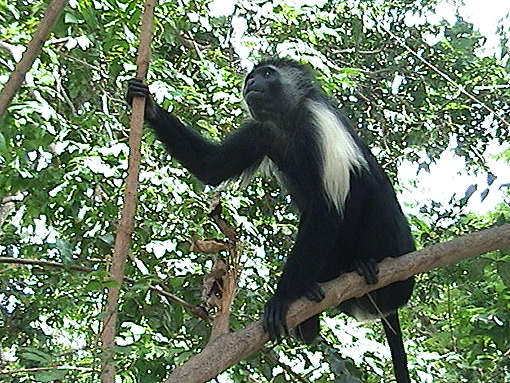
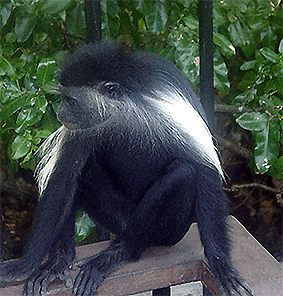
Two closeup pictures of mature monkeys in hotel's garden and sitting on a handrail at right.
The collaboration between Colobus Trust and KPLC (Kenya
Power Lines Co.) resulted in weekly tree-trimming around power lines.
Despite
the successful reduction of the overall number of deaths and injuries
in 2003
the electrocutions still accounted for 1/3 of all recorded primate
fatalities
in Diani. Since March 2004 one began the tree trimming with a more
tartargeted
approach by identifying electrocution hot spots. One concentrated with
the tree
trimming in these areas. In year 2004 there were only fifteen
electrocutions in
total, eight less then the previous year. Fourteen of these though,
have been Colobus
monkeys. With only 1800 Angolan black and white Colobus monkeys
remaining in
Literature:
DIANI’S MONKEYS by R. Eley and P.
Kahumbu,
© Robert Eley and Paula
Kahumbu,
ISBN: 92-91-46-027-3.
Address:
WAKULUZU:
FRIENDS OF THE COLOBUS TRUST,
Tel/Fax: + 254 (0) 40 320 3519
Email: info@colobustrust.org